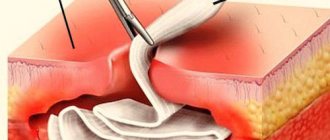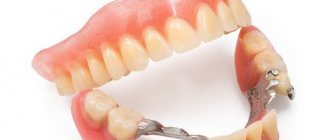Classification Causes of recession Diagnosis and consequences of recession Treatment methods Prevention
Gum recession is the process of loss of gum tissue, which exposes the neck of the tooth root. Visually it looks like this: due to the exposure of the root part, the teeth appear longer, and a small groove is formed at the edge of the gum. The sensitivity of teeth to sour, sweet, salty and temperature changes increases. Gum recession can occur in the area of one tooth or several. However, to establish an accurate diagnosis, you need to contact the dentist.
Why is this happening?
There are several causes of the disease:
- Significant deposits of stone and plaque. A toothbrush does not clean enamel well, and over time, deposits accumulate and push soft tissue toward the roof of the mouth.
- Ignorance of oral hygiene rules. Improper brushing of teeth leads to constant injury to the mucous membrane and a gradual decrease in its volume.
- Mechanical injuries. If a person puts foreign objects into his mouth, chews nuts, pencils, bites off threads, etc., this also disrupts the integrity and structure of soft tissues.
- Consequences of a broken jaw, dislocation of the temporomandibular joint, poorly fitted dentures, braces, chipped teeth, roughly placed fillings.
- Complications after treatment of cervical caries, for example, if the dentist accidentally touched the gum with a grinding disc.
- Contact of soft tissues with arsenic preparations when they are placed in a diseased tooth.
- Anomalies of the structure of the oral cavity - short frenulum, shallow vestibule of the oral cavity, thin cortical bone, large alveolar process, malocclusion.
- Chronic infectious and inflammatory processes that destroy the structure of gum tissue - periodontal disease, gingivitis, abscesses, etc.
- Impact of nicotine.
- Vitamin C deficiency.
- Bruxism is involuntary grinding.
If you have a problem similar to that described in this article, be sure to contact our specialists. Don't diagnose yourself!
Why you should call us now:
- We will answer all your questions in 3 minutes
- Free consultation
- The average work experience of doctors is 12 years
- Convenient location of clinics
Single contact phone number: +7
Make an appointment
Treatment for gum recession should begin as soon as possible. To catch the disease at an early stage, you need to visit the dentist at least 2 times a year. It is impossible to see the first changes on your own.
Signs that you may need extensions
It is recommended for all patients who notice all or only a few of the following symptoms to think about how gum tissue is built up: exposure of the necks and roots, enlargement and lengthening of the crowns, swelling and redness of the mucous membrane, bleeding from any mechanical impact, the appearance of gum pockets (the gum exfoliates and moves away from the tooth), increased interdental spaces, tooth mobility, increased sensitivity to hard, cold, hot, sweet, spicy and salty foods.
Often, in addition to the listed signs, patients who have recession note a strong accumulation of plaque at the border of the enamel and gums, as well as the appearance of bad breath, which is in no way associated with eating food or lack of daily hygiene.
How to fix the problem?
To achieve 100% gum regeneration, you need to consult a doctor as soon as you notice a shift in the gingival margin. The type of treatment for gum recession depends on the stage of the disease.
If the drooping is insignificant, does not exceed 2-3 millimeters, the roots are not exposed, then they speak of an early stage. In this case, drug treatment of gums is indicated - protein preparations based on amelogenins are prescribed, which help restore damaged and form new healthy dental structures. Thus, the natural forces of the body are used. The advantage of drug treatment for gum recession is its safety and good effectiveness, but in severe forms it is useless.
Another method of treating gum recession without surgery is to inject collagen into the affected tissue. Collagen is a natural substance for our body and does not cause allergies or rejection. It stops inflammation and promotes tissue restoration at the initial stage. Collagen treatment is most effective for gum recession caused by severe inflammation. If the cause of prolapse is injury, then collagen will not help here.
In the moderate and severe stages - the tissues drop to 6 mm - treatment is carried out only surgically. There are 3 ways:
- Transplantation of a flap of your own healthy tissue onto the affected area. It is used in most cases and is highly effective. The disadvantages include discomfort in the area where the flap was taken and the risk of rejection.
- The placement of fibrin membranes formed from the patient’s own blood allows for complete tissue restoration, significantly reducing the risk of relapse, reducing postoperative swelling and shortening rehabilitation time.
- Implantation of separation membranes between gingival and dental tissues. A rigid membrane promotes better bone tissue restoration and eliminates prolapse by more than 70%. The disadvantage of this method is that later you will have to undergo a second operation to remove the membrane.
How and how to treat gum recession is decided only by the treating dentist. The cost of treating gum recession depends on the severity of the disease and the amount of work performed.
What can you do at home?
Is it possible to grow gums at home? No, this is impossible to do. But you can eliminate the traumatic factor and change personal hygiene products if they are the cause of the problem.
At home, you can also use decoctions of various herbs (chamomile, sage, oak bark), antiseptics and oils (with vitamin E, sea buckthorn, tea tree), lotions with gels and ointments to eliminate inflammatory processes and rapid regeneration of periodontal tissue. However, these remedies are ineffective as an independent measure. It is better to use them in combination with the procedures and pills prescribed by the doctor, based on the individual clinical situation.
Prevention of gum recession
- Don't start caries. Place high-quality fillings in a timely manner and prevent the appearance of cervical caries.
- Keep your mouth clean. Follow your teeth brushing technique.
- Have your hair professionally cleaned at least once every six months.
- Avoid injury.
- Massage your gums regularly.
- Take mineral-vitamin complexes with vitamins A, D and group B.
Do not forget that at an early stage it is easier, faster and cheaper to cure the disease. Therefore, consult a doctor as soon as you notice its first signs.
Main indications for the procedure
- violation of the aesthetics of the smile due to injuries and incorrect previous treatment,
- the presence of deep periodontal pockets, exposure of roots, increased sensitivity of enamel, tooth mobility,
- gingivitis, periodontitis and periodontal disease,
- tissue deficiency after tooth extraction: most often, gum and bone are built up for the implant, otherwise, when installing it, the maxillary sinuses or trigeminal nerve can be injured. If there is insufficient tissue volume, there is a high risk that the artificial root will not have good stability and will not take root, and the prosthesis will look ugly and unnatural.
“Those who do not pay attention to the problem for a long time and do not solve it in any way risk the development of cervical and basal caries, pulpitis, wedge-shaped defect, the formation of unattractive three, loosening and loss of teeth at a very young age,” says Dzhutova Aida Vladimirovna, periodontist.
Splitting, decementing, periodontitis
Even if the bridge is slightly damaged in the place where it comes into contact with artificial prostheses, its position will certainly change over time. This will cause the crown to injure the surrounding soft tissue.
Disintegration of a free-standing crown often occurs. This is also possible in case of negligence of the treating dentist or due to a large amount of salivary fluid getting under the crown. Possible reasons include insufficient preparation of the oral cavity for the installation of crowns.
Before fixation, the doctor must sanitize the teeth and gums; if this is not done in time, bacteria may remain on the surface of the teeth. As a result, periodontal disease or periodontitis may develop. These diseases are characterized by a gradual change in the location of the affected units, which can also lead to an increase in the gap between the crown and the gum. The patient's attempts to clean his teeth using toothpicks and hard brushes are also provoking factors.
Methods of bone growth during implantation
- sinus lift: performed exclusively on the upper jaw. The doctor moves the bottom of the mucosa and fills the resulting hole with bone material. The procedure can be open or closed. With a closed operation, simultaneous installation of an implant is possible; with an open operation, the implant can be installed only after 4-6 months, that is, when the material has successfully taken root and the tissues have healed,
- replantation of bone blocks: material for the operation is taken from the chin or mandibular region of the patient himself,
- alveolar ridge cleft: a traumatic operation that is rarely performed today,
- directed bone regeneration: characterized by low trauma, involves the installation of special membranes that accelerate the processes of bone formation. For minor atrophic processes, it can be used in conjunction with implantation.
Read more about all types of bone grafting in the feature article on the website.
It is very important to emphasize that experienced doctors working in equipped clinics try to avoid complex augmentation surgeries that require long-term rehabilitation. Especially when it comes to restoring a large number or all teeth at once.
Today, the problem of missing teeth is solved without extension procedures using one-stage implantation methods. The protocols use special implant models that can be installed at an angle and capture the maximum volume of healthy tissue. The fixed and functional prosthesis is then fixed for 2-3 days.
How is gingivoplasty performed?
The operation does not require hospitalization or general anesthesia. The procedure can be performed as an outpatient visit to a doctor and under local anesthesia. With the help of effective modern anesthetics, gum grafting is performed completely painlessly.
If it is difficult for the patient to attend his own operation, then various options for premedication and sedation are provided for this.
In most cases, if it is necessary to fill the gum volume, the use of a donor flap is required. Often this is a fragment of the patient’s own mucosa from the tubercle of the upper jaw, palate or the area behind the lower teeth (retromolar). The area from which donor material is collected is dictated by the type of manipulation and the volume of tissue required.
In case of insufficient number of donor tissues, artificial materials are used. Plastic surgery of the lower gum is considered easier, but in reality, healing of the mucous membrane after surgery in any case occurs rapidly - in the oral cavity, tissue regeneration occurs very quickly.
Types of gingivoplasty
Depending on the diagnosis and health status of the patient, the surgical tactics may vary.
- When it is necessary to increase the gum or fill its defect - gingivoplasty
First, the site where the donor site will be placed is prepared, and then a free connective tissue graft is collected. After suturing the donor flap with the recipient area, the intervention is considered complete.
Sometimes the graft is placed in the implant area into a pocket or tunnel formed in the recipient area. To do this, the donor fragment is first de-epithelialized.
There are other methods, their choice is dictated by indications and capabilities.
- In case of incomplete tooth eruption - gingivotomy
An incision is made in the gum in the area of the tooth crown. The size of the excised area depends on the position and size of the tooth.
- If there is excess mucosal tissue – gingivectomy
If there is a periodontal pocket or various types of hypertrophy, the surgeon excises excess mucosa and tightly suturing the edges of the wound so that the mucosa is at the desired height and tightly covers the necks of the teeth.
Operation duration
The intervention can last 1-3 hours, depending on the volume and degree of complexity. The most complex situations are treated in several stages. For example, in order for the patient to undergo gum surgery more comfortably, it is recommended to operate on each side (left, right) in turn - then he will be able to chew food and sleep on at least one side.
Rehabilitation after gum surgery
Due to the high speed of regenerative processes in the oral cavity, gum healing after plastic surgery occurs in just 1-2 days. It is during this period that it is important to follow the rules of rehabilitation and the doctor’s recommendations to accelerate the epithelization of the wound, so that pain after gum surgery does not bother you too much:
- Avoid solid and irritating foods - sour, salty, spicy, cold;
- Stop smoking, alcohol, active sports, and shaking in transport;
- Carry out hygienic care very carefully (don’t even rinse too vigorously);
- Do not make suction movements, do not touch the wound with your tongue or any objects;
- Try to eat alkaline foods, as acidification of the pH of saliva promotes inflammatory processes.
How long it takes for the gums to heal completely after plastic surgery, that is, with complete restoration of blood supply, innervation and molecular connections, depends on the individual characteristics of the patient’s body. Sometimes final rehabilitation can take up to 3 months.
Swelling after gum surgery goes away within a few days (up to a week). At this time, slight tooth mobility and hypersensitivity are allowed. Some clinics provide the patient with a special mouthguard with a disinfecting effect, which accelerates wound healing.
What effect can be expected after gingivoplasty?
In addition to correcting aesthetics, the goal of surgical intervention is to prevent the development of many complications - tooth loss, deepening of periodontal pockets, the formation of wedge-shaped defects, hypersensitivity of the necks and roots of teeth.
Thanks to gingivoplasty, hygiene is facilitated, bleeding gums, bad breath, inflammation are eliminated, and tartar forms more slowly. Also, after plastic surgery, the possibilities for prosthetics and implantation expand - the patient has fewer contraindications for any dental procedures and manipulations.
Perioplasty - plastic surgery of the gums around implants - improves blood circulation in the implantation area, hygiene, and extends the life of artificial roots.
Complications after gum surgery
The operation can have complications during the rehabilitation period only if:
- Incorrect history taking - the doctor did not find out (or the patient was able to hide) the patient’s health problems, the presence of factors that complicate wound healing (for example, with immune problems);
- Non-compliance with the doctor’s recommendation - if the patient has neglected the rules of gentle care, does not follow the instructions for anti-inflammatory therapy, disinfection, lifestyle and others;
- Medical error - in case of infection in the wound, leaving a foreign body (bandage thread, bone fragment).
On the last point, gum plastic surgery is the least likely to have complications, because modern operating algorithms and antiseptics, sterile packaged instruments and suture material, disposable consumables - all this leaves practically no chance for infection.
It is much more important to take seriously the rules of the postoperative period, not to smoke, to make a proper menu and to care for the wound surface as necessary.
Existing treatments
Elimination of gum recession in Kaliningrad is possible only with the help of a surgical operation, the purpose of which is:
- restore the gum contour;
- cover exposed tooth roots.
There are several surgical treatment options:
1. Transplantation method (flap surgery)
The essence of the operation is to transplant a section of gum tissue taken from the upper palate to the area of recession. The resulting graft is sewn in such a way that it covers the roots of the tooth. After 1-2 weeks, the doctor will remove the stitches and give all the necessary care recommendations.
2. Gum regeneration
Gum grafting methods can be combined with the use of guided regeneration techniques, which involve the use of special membranes for tissue growth. Fibrin or collagen membranes promote the growth of new cells and accelerate the regeneration process in tissues. They may resolve on their own or be removed surgically.
Note that the sooner gum plastic surgery is performed, the better the result will be and the less volume of surgical intervention will be.
And of course, before starting treatment of the disease, the causes that caused the problems are eliminated:
- pathogenic plaque is removed;
- inflammation is treated;
- frenulums are excised;
- Bite problems are corrected.
Dentist's fault and inflammatory processes in the oral cavity
One of the most common reasons for a large gap to appear is a medical error. This can happen due to the crown fitting too tightly to the soft tissue or, conversely, if the installation of the structure is insufficiently strong.
However, a large gap does not always appear due to the doctor’s fault. Sometimes the reason for this is the presence of serious inflammatory processes, for example on the interdental papillae, in the gums or in the tissues that surround the tooth itself. Quite often, complications appear against the background of a general deterioration in a person’s health and when the functioning of his immune system is disrupted.
Other reasons: insufficient oral hygiene, as well as allergic reactions to the drugs and materials used in the work of the master. If the tightness is broken and the strength of the crown fixation decreases, visible gaps may also form over time. In any case, the situation requires immediate intervention by qualified medical personnel.
Options for restoring gum aesthetics during implantation
- installation of a gum former: this design helps restore the beautiful anatomical shape of the gum, compact the tissue around the implant and create a highly aesthetic restoration that looks no different from a natural tooth. The former is placed on the implant when restoring single defects using classic two-stage implantation. It is installed 4-6 months after implantation and shortly before permanent prosthetics (2-3 weeks), when the artificial root acquires good stability,
- installation of an abutment: in some cases, the role of a shaper can be performed by an abutment connecting the implant and the prosthesis. This happens when the installed implant immediately has good stability, and a lightweight crown is fixed on top of it,
- prosthesis with artificial gum: this option is suitable for patients who restore many teeth or all at once. In this case, the orthopedic structure is equipped with an artificial gum, which makes the smile attractive and relieves the patient of the need for mucosal plastic surgery.











